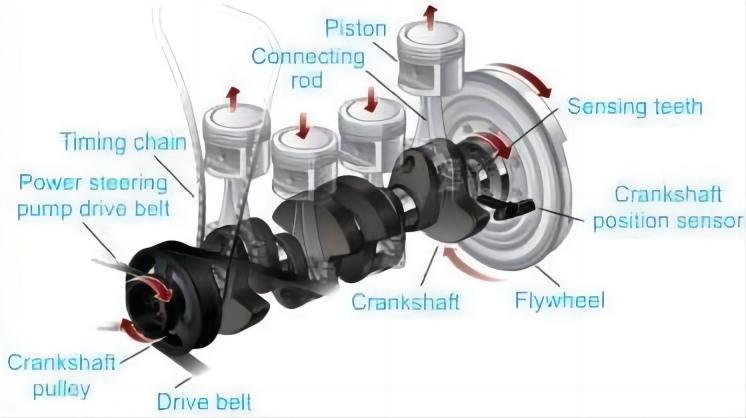In the intricate dance of internal combustion engines, precision is key. Among the many components orchestrating this symphony, the Crankshaft Position Sensor plays a pivotal role, and at its heart lies the Hall Effect sensor. In this article, we delve into the significance of Hall Effect sensors in detecting the crankshaft’s position and speed, highlighting their vital role in engine operation and ignition timing.
The Essence of the Crankshaft Position Sensor
The Crankshaft Position Sensor (CPS) is a small but crucial component hidden in the engine bay. Its main job is to keep an eye on the crankshaft’s speed and position, feeding vital information to the Engine Control Unit (ECU). This data is essential for coordinating fuel injection and ignition timing, ensuring the engine runs smoothly and efficiently. Think of the CPS as a watchful guardian, quietly working behind the scenes to maintain the engine’s balance and performance. It’s like the conductor in an orchestra, making sure all the parts play together harmoniously. This sensor may be humble in size, but it plays a big role in the technology that keeps our vehicles running at their best.
The Hall Effect Unveiled
At the core of many Crankshaft Position Sensor units, the Hall Effect sensor is a semiconductor device that responds to magnetic fields. Named after physicist Edwin Hall, who discovered the phenomenon in 1879, the Hall Effect is a fundamental principle that describes the generation of a voltage difference (Hall voltage) across an electrical conductor when exposed to a magnetic field perpendicular to the current flow.
In the context of CPS, the Hall Effect sensor is strategically placed to interact with the rotating teeth or notches on the crankshaft. As these teeth pass by the sensor, they induce a magnetic field variation, causing the Hall Effect sensor to generate a corresponding voltage. This voltage signal is then converted into a digital output, serving as a precise indicator of the crankshaft’s position and speed.
How Hall Effect Sensors Enhance Engine Performance
Precision in Crankshaft Positioning
Hall Effect sensors offer high precision in detecting the exact position of the crankshaft at any given moment. This level of accuracy is crucial for synchronizing various engine components, such as the camshaft and the fuel injection system. The ECU relies on this precise data to ensure that fuel injection and ignition timing are precisely timed for each cylinder.
Dynamic Adjustments for Variable Conditions
In dynamic driving conditions, the engine experiences varying loads and speeds. Hall Effect sensors continuously monitor these changes in real time, allowing the ECU to make split-second adjustments. This adaptability is particularly important for optimizing combustion efficiency and overall engine performance under different driving scenarios.
Fuel Injection Optimization
Real-time data from Hall Effect sensors enables the ECU to finely control the duration and timing of fuel injection pulses. This optimization ensures that the right amount of fuel is delivered precisely when needed, leading to efficient combustion and improved fuel economy. Additionally, it contributes to reduced emissions by minimizing unburned fuel.

Enhanced Engine Performance and Response:
The real-time nature of Hall Effect sensor data contributes to enhanced engine responsiveness. Quick adjustments to fuel injection and ignition timing result in improved throttle response, making the driving experience more enjoyable and providing better control over the vehicle.
Ignition Timing Precision
Ignition timing plays a crucial role in the combustion process. Hall Effect sensors provide the ECU with immediate feedback on the crankshaft’s rotational speed, allowing the system to adjust ignition timing on the fly. This precision contributes to smoother engine operation, increased power output, and reduced likelihood of engine knocking.
Integration with Advanced Engine Control Strategies
The availability of instantaneous data from Hall Effect sensors facilitates the implementation of advanced engine control strategies. This includes features such as variable valve timing (VVT) and cylinder deactivation, which further optimize performance and fuel efficiency.
Where is Located Crankshaft Position Sensor
The crankshaft position sensor is typically located near the crankshaft pulley or harmonic balancer. It is mounted on the engine block, often on the front or side. The sensor may be positioned close to the crankshaft gear or tone ring, which rotates with the crankshaft. In some cases, it may be found on the transmission bell housing. I’ll provide you with a more detailed explanation.
| Location | Description |
| Near Crankshaft Pulley/Harmonic Balancer | Located at the front of the engine near the crankshaft pulley or harmonic balancer. Positioned on the engine block, often on the side or bottom. |
| Close to Crankshaft Gear or Tone Ring | Positioned near the crankshaft gear or tone ring, which is a notched wheel attached to the crankshaft. The sensor reads notches to determine the crankshaft’s position. Located on the front or side of the engine block. |
| Transmission Bell Housing | In some rear-wheel-drive vehicles, the sensor may be located on the transmission bell housing. Monitors the crankshaft’s rotation without being mounted directly on the engine block. |
| Consult Repair Manual | For precise information on the sensor’s location in a specific vehicle, refer to the vehicle’s repair manual. The manual provides detailed instructions, diagrams, and specifications. |
| Seek Professional Assistance | If unfamiliar with automotive repair, it’s advisable to consult a professional mechanic for assistance. Mechanics have the expertise and tools to efficiently locate and replace the crankshaft position sensor. |

Hall Effect sensors stand as critical components that enable modern engines to operate with unprecedented precision and efficiency. Their real-time data accuracy empowers the ECU to make split-second decisions, resulting in optimal combustion, improved fuel efficiency, and enhanced overall engine performance. As automotive technology continues to advance, the role of these sensors becomes increasingly integral to achieving the highest levels of efficiency and performance in internal combustion engines.
Know about more automotive hall effecf sensor recommed reading :
How to Relearn Camshaft Position Sensors?
Throttle Position Sensors: Unveiling the Precision of Hall Effect Sensors
Wheel Speed Sensors: Unveiling the Essence of Hall Effect Technology











